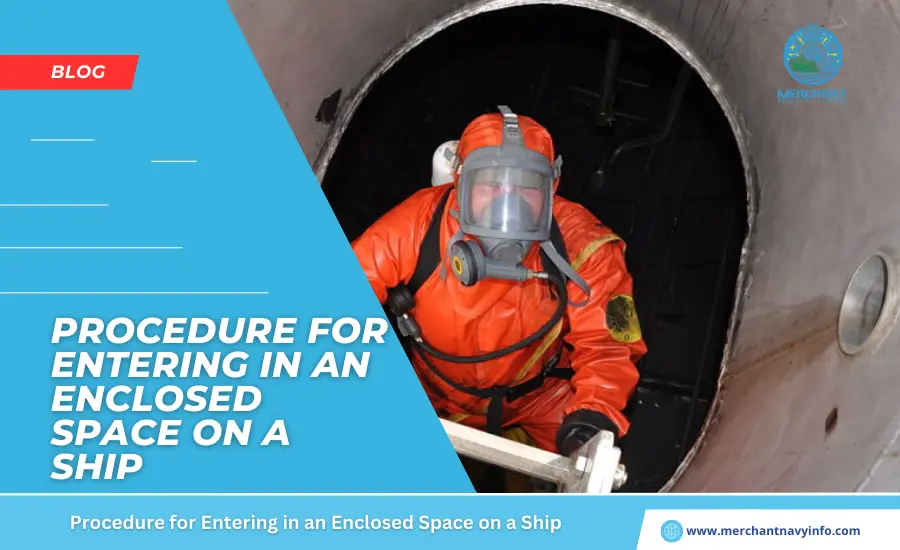
From the inside, the ship is a complex structure with several small enclosed space. Many of these enclosed spaces are used for machine installation and also storage of machine parts and workshop equipment. A ship has a network of pipes running through all parts, including enclosed spaces. Confined spaces can be used for a variety of purposes. However, the main problem arises when you have to enter these enclosed spaces for repair work or cleaning purposes.
Unfortunately, there have been a number of recent incidents involving personal injury, death, and accidents in confined spaces due to failure to follow proper procedures for entering confined spaces. Despite shipping companies warning of the dangers and providing appropriate training, too many seafarers still die or are seriously injured.
What Is A Closed Space?
A closed space is a space that is not used for daily activities and has any of the following characteristics:
- For access Limited openings
- Inadequate ventilation
- It is not designed for the permanent residence of workers.
The presence of any of the above characteristics can result in a room becoming an enclosed space. A ship-specific list of all confined spaces on board must be prepared and also posted in a publicly accessible location. The most common confined spaces onboard ships are holds, chain lockers, cofferdams, water tanks, cavities, channel keels, fuel tanks, engine crankcases, exhaust tanks, and also scavenging tanks. Areas on board that remain closed without ventilation for long periods must be considered hazardous.
Changes in the environment in a room that has not been designated as unsafe can also cause the room to become unsafe, such as the failure of reliable ventilation or the release of harmful gases from adjacent hazardous rooms. It is wise not to enter dangerous rooms. However, the crew onboard ships carry out maintenance work for a variety of reasons, including regular inspections of tanks (ballast tanks, DB tanks), ensuring that tanks are dry before loading, and cleaning tanks and holds, including maintenance, painting, and repairs. You will be required to enter an enclosed space.
Hazards and Hazards Associated with Enclosed Space
1. Oxygen Deficiency
The permissible oxygen level in a confined space is 19.5% to 23.55. Oxygen levels in any room can be reduced by various factors, but the most common is rust on steel parts. We all know that rust is nothing but an oxidation process. Oxygen is consumed in the process. Oxygen is also consumed by activities such as hot working, welding, and starting fires. If inert gas enters the room, it can cause a drop in oxygen levels. Discharge residual traces such as iron ore and coal can absorb oxygen.
2. Hazardous Fumes
The presence of toxic fumes can make a room deadly, even if there is no oxygen deficiency or even if the room has plenty of oxygen. Inhalation of toxic gas can cause eye irritation, headaches, and even loss of consciousness. High concentrations of toxic gases can also cause death.
3. Leakage
Of hazardous substances from adjacent rooms. The accidental spillage of dangerous substances from adjoining rooms can pose noteworthy dangers to both well-being and security. Such episodes can happen due to different reasons, such as defective control frameworks, harmed pipelines, or human blunders.
4. Inadequate or No Ventilation
There is a high risk that toxic gases are present or oxygen is not present, both of which are fatal to humans.
5. Limited Space
Limited space in each compartment can make rescue operations from such rooms difficult. Personnel must understand the structure of a confined space before attempting to enter it.
6. Personal Injury
Due to slips, trips, and falls. These confined spaces lack ventilation, allowing toxic gases to form and also accumulate from chemicals stored there and from leaking pipes. Entering such areas without precautions can result in unconsciousness and even death. Many indoor accidents occur in the shipping industry that not only pose health risks but also result in loss of life. Despite strict checklists and work permits, our seafarers continue to die.
Listed Below Are Some Important Issues That Are Often Overlooked.
- Failure to recognize hazardous confined spaces and all associated hazards.
- Lack of awareness of the dangers of carry-on items.
- Unplanned and poorly executed rescue operations.
- Lack of understanding or non-compliance with company procedures.
Checklists
It should not be treated as just check items. It is necessary to appropriately implement a ship safety management system. There are many safety precautions that need to be taken seriously to prevent accidents and also injuries in confined spaces. Checklists are created for a reason. Compliance with procedures is a rescuer’s first line of defense against injury or death.
- Misuse of important safety equipment
- Failure to follow required safety precautions
- Unplanned and improperly executed rescue operations
- Acting on emotion and instinct, ignoring knowledge and training
- People, I don’t think that will happen to me.
- Impulsive behavior can be deadly.
It’s human nature to want to save our colleagues, and also that desire causes rescue workers to attack us without proper safety precautions.
Lack of Intervention
To prevent such unfortunate situations, proper procedures must be followed to ensure the safety and health of those entering confined spaces.
Confined Space Entry Procedures
Before entering a confined space, the following points must be observed:
Oxygen depletion occurs when entering a confined or enclosed space, so a risk assessment should be carried out competently. Must be carried out by qualified personnel. Risk assessment is one of the most important preparation tools when entering a confined space. It addresses all aspects of the approach and seeks to minimize the likelihood of an accident by identifying hazards, determining control measures, and also finding alternatives or solutions or means of reducing risks. RA must be run every time before man entry. A list of tasks to be completed should be created to facilitate evaluation.
Example
When welding work or piping replacement is required, this allows you to perform your work quickly and easily.
- Potential hazards must be identified. Presence of toxic gases.
- Precautions should be taken to perform opening, closing, and securing and check whether the confined space opening is pressurized.
- When carrying out hot work, the risk of fire must be minimized. This can be done by emptying fuel or chemical tanks near hot workplaces.
- Closed rooms should be thoroughly ventilated before entering. Sufficient time must be allowed to set up the ventilation system to ensure a supply of air containing enough oxygen to sustain life. Ventilation can be either natural ventilation or mechanical ventilation using fans.
- Oxygen analyzers and gas detectors should be used to check the levels of oxygen and other gases in the room. Air test equipment must be capable of measuring the presence of carbon monoxide and hydrogen sulfide.
- Proper work permits must be completed, and checklists must be checked to avoid life-threatening accidents. Entry into confined spaces may only be made by trained and knowledgeable persons with a licensed and issued permit.
Permits To Work In Confined Spaces Specify
- Work location
- Nature and limitations of work
- Details of the work team and tools used
- Possible hazards
Precautions Include
- Taken – to the protective equipment used
- Time of issue and its validity – agreed communication methods and intervals
- Signature of the person when the permit is issued and when the work is completed
- The permit Recipient’s signature
A work permit may only be valid for a limited period of time. If it expires, a new permit must be issued, and a checklist must be completed. Working in an enclosed space requires verification and approval of a work permit by the Master. Appropriate signs and work markings must be installed at required locations to prevent equipment or machinery from starting or working in confined spaces that endanger the lives of workers.









